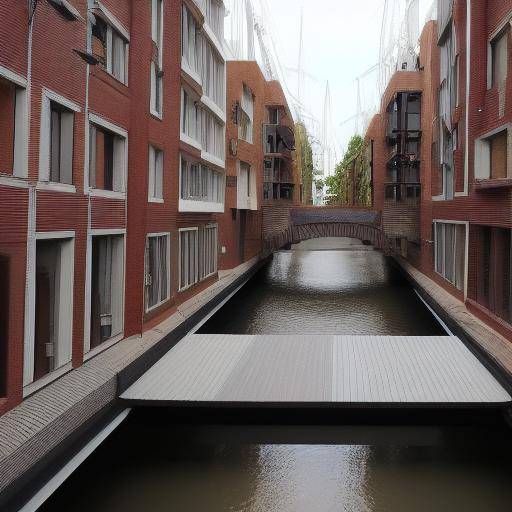
The canals of Amsterdam are not only a tourist attraction, but also a testimony of human ingenuity in water management. The complex management of these channels, flood control and the development of the surrounding infrastructure are challenges that this masterpiece of engineering has successfully addressed over the centuries. This article explores engineering lessons behind the hydraulic design of Amsterdam's canals and its influence on technical education and modern urbanism.
Introduction
The design of the canals of Amsterdam reflects the hydraulic mastery and the ability to adapt humanity to transform the natural environment into an example of sustainable urbanism. Over the centuries, these channels have witnessed crucial advances in urban engineering, deeply affecting technical education. This article examines how these aspects are intertwined to form a unique heritage that continues to influence our contemporary urban and educational systems.
History and Background
Origen of the Amsterdam Canals
Amsterdam, with its iconic channels, has been recognized worldwide for its hydraulic engineering. The development of these channels began in the seventeenth century, during the "Gold Age" of the Netherlands. The need to expand the city and control the surrounding waters led to the creation of a meticulous design that led to the network of channels we know today. This innovative approach in urban engineering not only allowed the planned growth of the city, but also set a precedent for future innovations in this field.
Historical Impact
The design of the canals in Amsterdam allowed the expansion of the city in an organized manner, controlling the waters and facilitating trade and transport. This network of channels became a model of water management, influencing other cities and establishing fundamental principles in hydraulic engineering and urbanism.
Analysis in Deep
Principles of Hydraulic Engineering
Amsterdam's pioneering approach to hydraulic engineering has served as a model for other cities facing similar challenges. The basic principles include rainwater management, the construction of dikes and locks, and the implementation of efficient pumping systems. These principles not only ensured the inhabitability of Amsterdam, but also allowed its economic prosperity.
Innovations and Advances
Amsterdam has been a living laboratory for innovation in hydraulic engineering. Over the centuries, engineers have introduced technological improvements that have allowed the adaptation and sustainability of the channel system. These innovations include the use of advanced materials, improved construction techniques and more accurate water monitoring and control systems.
Comparative analysis
Comparison with Other Cities
Compare Amsterdam channels with other water management systems in cities such as Venice and Hamburg reveals the uniqueness of the Dutch approach. While Venice struggles with sea level rise and Hamburg faces regular floods, Amsterdam has maintained a remarkable balance between urbanization and sustainable water management. This comparison highlights the importance of robust technical education adapted to local challenges.
Lessons Learned
The lessons learned from Amsterdam are numerous. The integration of hydraulic engineering into urban development, the importance of long-term planning and the need for continuous innovation are key aspects that can be applied to other urban contexts. These lessons underscore the need for technical education to prepare engineers to address complex challenges with sustainable solutions.
Practical Tips and Accessible Recommendations
Technical education
For those interested in following the steps of the engineers who designed the canals in Amsterdam, it is essential to acquire a solid basis for technical education. Academic programs that integrate both the theoretical and practical aspects of hydraulic engineering are essential to understanding and addressing current and future challenges in this area.
Interdisciplinary approaches
Promoting collaboration between disciplines is crucial. Hydraulic engineering does not operate in isolation; it interacts with architecture, urbanism, the economy and the environment. Future engineers should be prepared to work on multidisciplinary teams to develop comprehensive and sustainable solutions.
Use of Advanced Technology
The implementation of advanced technology, such as intelligent sensors, real-time monitoring systems and predictive models, can significantly improve water management. The adoption of these technologies is essential to maintain and improve channel systems in a world facing climate change and accelerated urbanization.
Conclusion
Summary and Final Reflections
The canals of Amsterdam are not only a wonder of hydraulic engineering, but also a living legacy of innovation and adaptation. They have shown how the combination of careful planning, advanced engineering and sustainability commitment can create a functional and beautiful urban environment.
Future of Hydraulic Engineering
As we face new global challenges, such as climate change and rapid urbanization, Amsterdam's lessons are more relevant than ever. Technical education in hydraulic engineering should evolve to include these lessons and prepare future engineers to lead in the creation of sustainable and resilient solutions.
Frequently asked questions
Question 1: How is the Amsterdam Canal Network currently maintained?Answer: The Amsterdam channel network is maintained through a combination of modern and traditional techniques, including pumping systems, locks and constant monitoring of water level.
Question 2: What role do channels play in the daily lives of Amsterdam's inhabitants?Answer: The channels are fundamental in daily life, providing transportation, flood control, and being an important tourist attraction.
Question 3: What other cities have adopted practices similar to those in Amsterdam in water management?Answer: Cities such as Venice, Hamburg and Copenhagen have adopted and adapted water management practices inspired by Amsterdam to face their own hydraulic challenges.
Question 4: What recent innovations have been implemented in the Amsterdam channels?Answer: Recently, intelligent sensors have been implemented to monitor the level of water and the state of infrastructure, as well as improvements in construction techniques and sustainable materials.
Question 5: How can engineering students learn from Amsterdam channels?Answer: Students can learn from the canals of Amsterdam through specialized academic programs, study visits, and case analysis that address hydraulic engineering and water management.
Explore the canals of Amsterdam offers a valuable lesson on the intersection of engineering, urbanism and sustainability. This legacy of innovation and adaptation continues to inspire and guide engineers and urbanists around the world.
